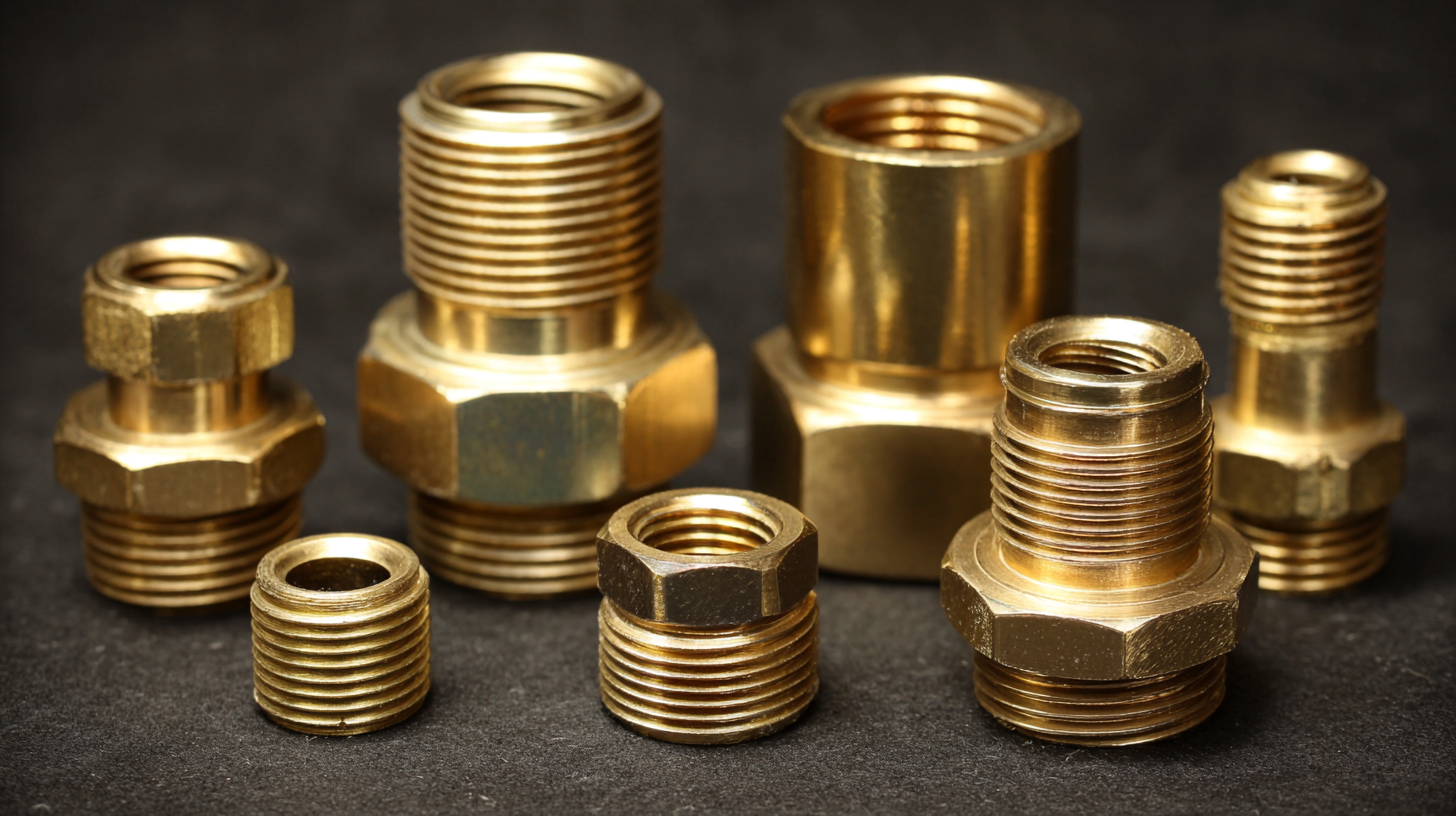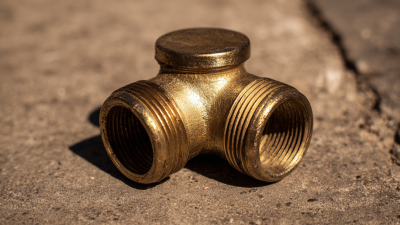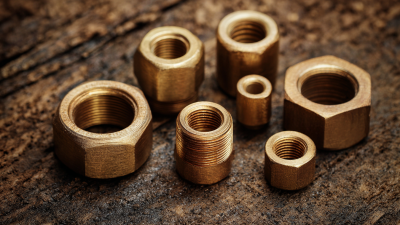How to Choose the Right Brass Fittings for Optimal Plumbing Efficiency
When it comes to optimizing plumbing efficiency, selecting the right brass fittings is crucial. According to recent industry reports, over 60% of plumbing failures can be attributed to improper fitting choices, leading to leaks, reduced water flow, and increased energy costs. Brass fittings, known for their durability and corrosion resistance, play a significant role in ensuring a seamless plumbing system.

A study from the National Association of Plumbing Contractors highlighted that projects utilizing high-quality brass fittings experienced a 30% increase in reliability compared to those utilizing lower-grade materials. Furthermore, the longevity of brass fittings significantly reduces the need for replacements, thus saving money and resources in the long term. Understanding the various types and applications of brass fittings is essential for homeowners, contractors, and plumbing professionals alike to achieve optimal performance and efficiency in their plumbing systems.
Understanding Different Types of Brass Fittings for Plumbing Needs
When it comes to plumbing, selecting the right brass fittings is crucial for ensuring optimal performance and longevity of your system. Brass fittings come in various types, each designed to serve specific purposes. Common types include elbows, tees, couplings, and reducers, which help to connect different sections of piping. Understanding the unique functions of each type can significantly impact your plumbing efficiency.
Tip: Always assess the specific needs of your plumbing project before selecting fittings. For example, if you need to change the flow direction, an elbow fitting will be your best choice. Conversely, if you’re looking to connect two pieces of pipe of the same size, a coupling is ideal. Be mindful of the pressure ratings and compatibility with other materials in your system to prevent leaks and ensure durability.
Another important factor is the finish of the brass fittings, which can influence their resistance to corrosion. Choose fittings with a high-quality finish to extend their lifespan, especially in environments with moisture exposure. Additionally, ensure fitting sizes match your pipes to avoid any awkward connections, which could lead to inefficiencies or leaks down the line.

Assessing Size and Compatibility of Brass Fittings for Efficient Flow
When selecting brass fittings for plumbing, size and compatibility are critical factors that influence overall system efficiency. Fittings should match the diameter and threading of pipes to ensure optimal flow without leaks. An incorrect size can lead to pressure losses or create flow restrictions, ultimately compromising the effectiveness of the plumbing system. It is essential to measure both the inside and outside diameters of the pipes before making a purchase, as well as to consider the type of connection needed—be it threaded, soldered, or compression.
Additionally, compatibility with existing materials cannot be overlooked. Brass fittings can interact differently with various metals due to galvanic corrosion, potentially leading to premature failure of components. Therefore, ensure that the brass fittings are suitable for the specific application and that they complement other materials used in the plumbing system. By carefully assessing size and compatibility, you can enhance the efficiency and longevity of your plumbing installations.
Evaluating Quality and Grade of Brass for Durability and Performance
When selecting brass fittings for plumbing applications, evaluating the quality and grade of brass is crucial for ensuring durability and performance. Brass is an alloy primarily composed of copper and zinc, and its characteristics can vary significantly based on the proportions of these metals and the presence of any additional elements. The most common grades for plumbing fittings are C36000 and C46400, with C36000 offering excellent machinability and corrosion resistance, while C46400 contains higher levels of tin, providing increased strength and durability, making it suitable for harsher environments.
In addition to the grade, the manufacturing process also impacts the overall quality of brass fittings. Fittings that undergo processes such as forging or casting are generally more reliable than those that are merely machined from extruded stock. Checking for certifications and standards, such as those from the American Society for Testing and Materials (ASTM), can ensure that the fittings meet specific performance criteria. This attention to quality not only prolongs the lifespan of the plumbing system but also reduces the risk of leaks, ensuring optimal efficiency in the long run.
Considering Corrosion Resistance Features in Brass Fittings Selection
When selecting brass fittings for plumbing applications, corrosion resistance should be a top priority. Brass, an alloy comprised primarily of copper and zinc, possesses inherent properties that can significantly enhance its durability and longevity in diverse environments. However, not all brass fittings are created equal; the composition and quality of the alloy can greatly affect their resistance to corrosion. For instance, fittings with added elements such as lead or nickel may experience different levels of corrosion based on the water chemistry and environmental factors they are exposed to.

In addition to composition, the surface treatment of brass fittings plays a critical role in determining their resistance to corrosion. Treatments such as electroplating or passivation can create a protective layer that minimizes oxidation and pitting. It’s also vital to consider the expected operating conditions, including temperature, pressure, and the presence of corrosive substances. Conducting thorough research and consulting with manufacturers can help identify fittings designed for specific applications, ensuring the selection of components that enhance plumbing efficiency and prevent costly repairs down the line.
Leveraging Professional Advice to Ensure Optimal Fitting Choices
When it comes to selecting brass fittings for plumbing systems, leveraging professional advice is crucial for ensuring optimal choices. Experienced plumbers and industry experts possess a wealth of knowledge regarding material properties, compatibility, and application requirements. These professionals can guide you through the nuances of various brass fittings, helping you select the best options tailored to your specific needs. By consulting with them, you can avoid common pitfalls that may arise from misguided decisions or lack of understanding.
Additionally, professionals can provide insights into the long-term performance and reliability of different fittings. They can recommend fittings that not only meet current plumbing standards but also enhance system efficiency and durability. Engaging with an expert can also aid in understanding the impact of environmental factors, such as water quality and pressure variations, on the functionality of your plumbing setup. Ultimately, prioritizing professional guidance will lead to more informed choices, resulting in a well-functioning, efficient plumbing system that stands the test of time.
How to Choose the Right Brass Fittings for Optimal Plumbing Efficiency - Leveraging Professional Advice to Ensure Optimal Fitting Choices
| Fitting Type | Application | Sizes Available (inches) | Material Standard | Leakage Resistance |
|---|---|---|---|---|
| Elbow Fitting | Pipe Direction Change | 1/2, 3/4, 1 | ASTM B16.22 | High |
| Tee Fitting | Branch Connection | 1/2, 3/4 | ASTM B16.15 | Moderate |
| Coupling | Joint Connection | 1/2, 3/4, 1 | ASTM B135 | High |
| Cap | End Closure | 1/2, 3/4 | ASTM B16.24 | High |
| Adapter | Connection Between Two Different Sizes | 3/4 to 1 | ASTM B16.22 | Moderate |
Related Posts
-

The Ultimate Guide to Sourcing High-Quality Brass Fittings for Your Business Needs
-

Essential Checklist for Choosing the Right Brass Elbow for Your Project
-

How to Choose the Best Brass Elbow for Your Plumbing Needs
-

Discover Exceptional PPSU PEX Fittings from Leading Chinese Manufacturers for Global Procurement
-

How to Choose the Right Compression Fittings for Your Plumbing Needs
-

The Future of Innovation in Ball Valve Technology
